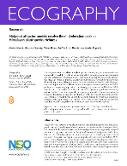Midpoint attractor models resolve the mid-elevation peak in Himalayan plant species richness

Autor
Dvorský, Miroslav
Datum vydání
2021Publikováno v
EcographyRočník / Číslo vydání
44 (11)ISBN / ISSN
ISSN: 0906-7590Informace o financování
UK/SVV/SVV260562
UK/PROGRES/Q43
Metadata
Zobrazit celý záznamKolekce
Tato publikace má vydavatelskou verzi s DOI 10.1111/ecog.05901
Abstrakt
The midpoint attractor (MPA) models of species richness integrate a unimodal environmental favourability gradient and neutral effects forced by geometric constraints and thus extend the ecologically neutral mid-domain model. However, both alternative MPA algorithms assume that underlying environmental favourability peaks within the modelling domain. Here, we used elevational distribution data for 1054 plant species occurring in northwest Himalaya to explore species richness gradients and MPA performance in species groups defined by biogeography, taxonomy and life-form. MPA models achieved an excellent fit, but the two MPA algorithms produced contrasting estimates of MPA location, especially for species groups with richness originating in lowlands. Therefore, we propose a modification of the MPA model accounting for the environmental favourability peak outside the study domain to reflect these situations. Biogeographic origin was more decisive for MPA location than taxonomic or life-form classification, indicating relatively low climatic niche conservatism in plants.
Klíčová slova
elevational gradient, geometric constraints, Himalayas, mid-domain effect, midpoint attractor, neutral theory, null models, species ranges, species richness peak, vascular plants
Trvalý odkaz
https://hdl.handle.net/20.500.14178/1652Licence
Licence pro užití plného textu výsledku: Creative Commons Uveďte původ 4.0 International






